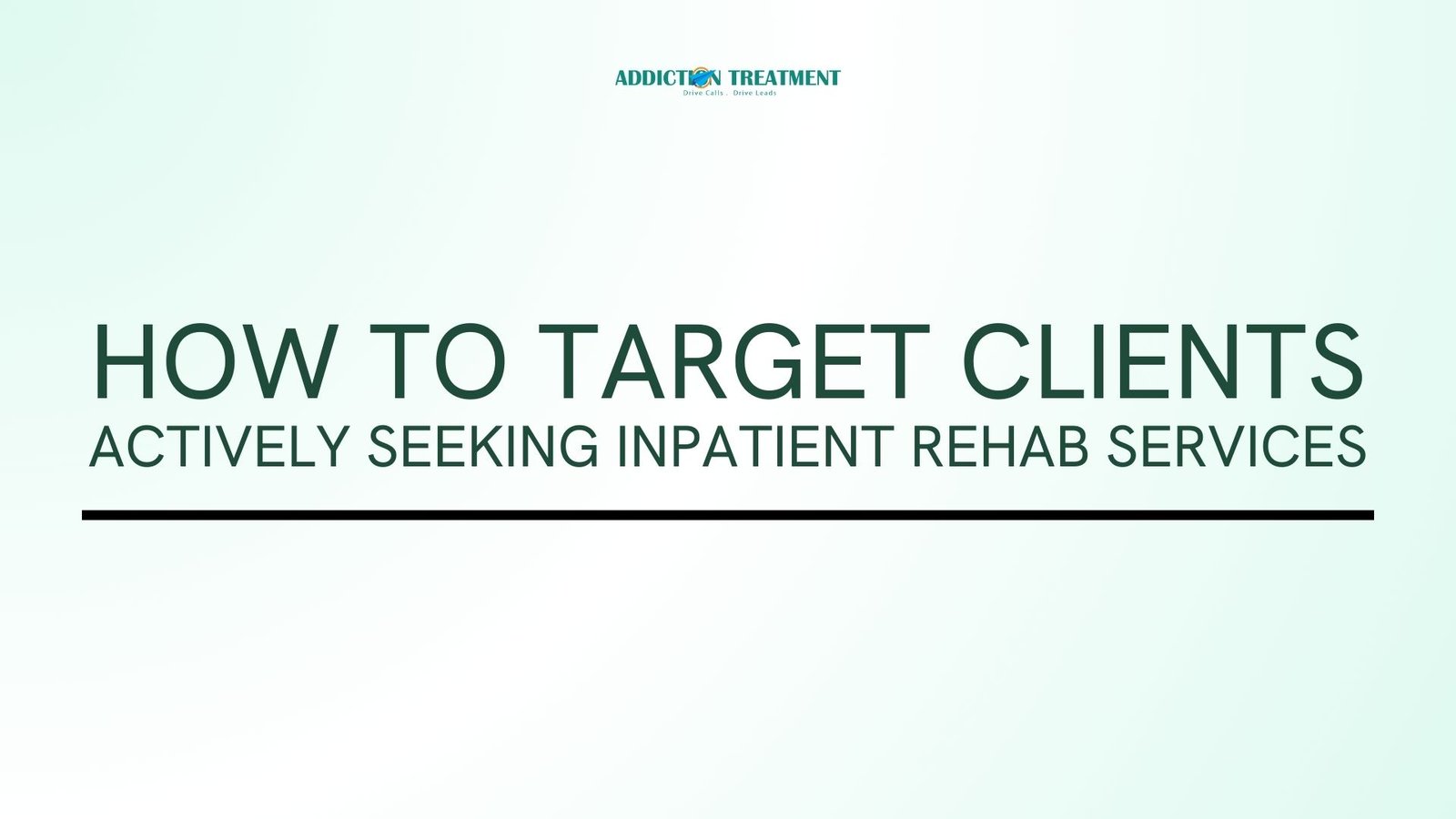Reaching clients who are actively seeking inpatient rehab services requires a strategic and focused approach. These individuals, often referred to as high-intent leads, are ready to take action but need guidance to connect with the right treatment center. In this article, we’ll explore actionable strategies to target these clients, optimize outreach efforts, and convert their interest into admissions.
Understanding the Inpatient Rehab Audience
Before crafting a strategy, it’s essential to understand who your target clients are and what drives their decision-making process. Clients actively seeking inpatient rehab services often share the following characteristics:
- High Urgency: They are looking for immediate help to address severe addiction issues.
- Support Network Influence: Families, friends, or healthcare professionals often play a role in encouraging them to seek treatment.
- Information Seekers: They research extensively, comparing treatment options, facilities, and reviews.
- Criteria-Driven: Their choice may depend on factors like location, cost, insurance acceptance, and program offerings.
By tailoring your approach to these needs, your treatment center can effectively reach and resonate with this audience.
Key Strategies to Target Clients Seeking Inpatient Rehab Services
1. Leverage Search Engine Optimization (SEO)
SEO is a powerful tool for capturing organic traffic from individuals searching for inpatient rehab services online. Focus on keywords that reflect their intent, such as:
- “Inpatient rehab near me.”
- “Residential addiction treatment centers.”
- “24-hour inpatient rehab facilities.”
Best Practices:
- Optimize your website’s service pages for location-specific keywords.
- Publish blogs addressing common questions, such as “What to expect in inpatient rehab?”
- Ensure your website loads quickly and is mobile-friendly to accommodate searches from smartphones.
2. Use Google Ads for Immediate Reach
Paid search campaigns allow you to target high-intent clients actively searching for inpatient rehab services. Google Ads lets you bid on keywords that trigger ads when someone searches for related terms.
Key Tips:
- Focus on High-Intent Keywords: Target terms like “same-day admission inpatient rehab” or “private residential addiction treatment.”
- Create Compelling Ad Copy: Highlight unique selling points (e.g., “24/7 medical care,” “insurance accepted,” “confidential treatment”).
- Utilize Location Extensions: Show your facility’s address and directions in the ad to attract local clients.
- Comply with Regulations: Obtain LegitScript certification to ensure your ads run smoothly and meet Google’s requirements.
3. Optimize Your Google Business Profile (GBP)
Your Google Business Profile (GBP) is essential for appearing in local search results and Google Maps. Many individuals searching for inpatient rehab services look for nearby facilities, making GBP optimization a must.
Steps to Optimize Your GBP:
- Include accurate contact information, address, and business hours.
- Add high-quality photos of your facility and amenities.
- Write a compelling description that includes location-specific keywords.
- Encourage satisfied clients or their families to leave positive reviews.
4. Develop Targeted Content Marketing
Educational content helps build trust with potential clients by addressing their questions and concerns. Focus on topics that resonate with those seeking inpatient rehab services.
Examples of Content Topics:
- “How Inpatient Rehab Differs from Outpatient Treatment.”
- “The Benefits of Residential Addiction Programs.”
- “What to Pack for a 30-Day Inpatient Rehab Stay.”
- “How to Choose the Right Inpatient Rehab Facility for Your Needs.”
Content should be published on your blog, shared on social media, and optimized for SEO to attract the right audience.
5. Engage with Pay-Per-Call Marketing
Pay-per-call campaigns are highly effective for inpatient rehab services, as they connect you directly with individuals ready to inquire or book a stay.
How It Works:
- Leads call a tracked number and are routed to your intake team.
- You pay only for qualified calls, ensuring your marketing budget targets high-intent clients.
This method captures immediate interest and often leads to higher conversion rates compared to traditional digital campaigns.
6. Partner with Referral Networks
Referral partnerships with healthcare providers, therapists, and social workers can drive consistent leads to your facility. These professionals often guide individuals toward treatment options, making them a valuable source of referrals.
Actionable Steps:
- Establish relationships with local hospitals and clinics.
- Offer educational materials about your services to referral partners.
- Provide incentives (where legally permissible) for referrals.
7. Invest in Local SEO
Local SEO ensures your facility is discoverable in geographic searches. Since most inpatient rehab clients prefer nearby facilities, targeting local keywords is crucial.
Best Practices:
- Create dedicated pages for each location you serve, optimized with keywords like “Inpatient rehab in [City].”
- List your facility in local directories and ensure NAP (Name, Address, Phone) consistency.
- Use schema markup to help search engines display rich information about your facility.
8. Use Social Media to Build Trust
While social media platforms aren’t the primary source of high-intent leads, they play a critical role in building trust and credibility. Share content that highlights:
- Client success stories.
- Facility tours and amenities.
- FAQs about inpatient treatment programs.
Engage with comments and inquiries promptly to foster a sense of connection and professionalism.
Converting High-Intent Leads into Admissions
Generating high-intent leads is just the first step. Converting them into admissions requires a seamless and compassionate approach:
- Respond Quickly:
High-intent clients expect prompt responses. Aim to follow up within minutes of receiving an inquiry or phone call. - Offer Clear Communication:
Clearly explain the admission process, costs, insurance coverage, and program details. Transparency builds trust and reduces uncertainty. - Train Your Intake Team:
Equip your intake team with the tools and knowledge to handle sensitive conversations empathetically and effectively. - Simplify the Admission Process:
Minimize barriers to entry by streamlining paperwork, offering online forms, and providing assistance with insurance verification.
Tracking and Optimizing Campaign Performance
To ensure success, regularly analyze the performance of your targeting strategies. Use tools like Google Analytics, call tracking software, and CRM systems to monitor key metrics, such as:
- Click-through rates (CTR) on ads.
- Cost per acquisition (CPA).
- Conversion rates from inquiries to admissions.
- Geographic performance to identify high-yield areas.
By identifying what works and refining your campaigns, you can continually improve your results and increase admissions.
Conclusion
Targeting clients actively seeking inpatient rehab services requires a combination of precision marketing, compassionate communication, and regulatory compliance. By leveraging strategies like local SEO, Google Ads, content marketing, and referral partnerships, your treatment center can connect with high-intent clients and guide them toward recovery.
Implementing these tactics not only boosts your admissions but also ensures your facility stands out as a trusted resource in the addiction treatment community.


Leave a Reply